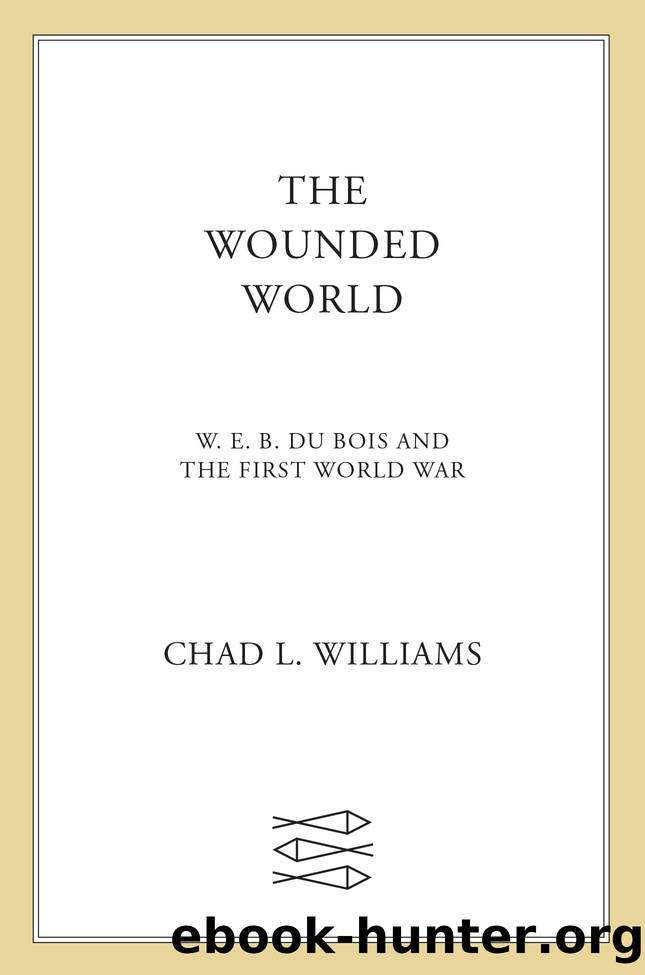The Wounded World by Chad L. Williams

Author:Chad L. Williams
Language: eng
Format: epub
Publisher: Farrar, Straus and Giroux
* * *
DU BOIS DESCRIBED THE decade after World War I as one of âinfinite effort and discouraging turmoil.â28 The remainder of 1924 and the early months of 1925 certainly reflected this. His clash with Marcus Garvey reached its ugly climax as the two iron-willed men traded increasingly personal barbs over who had the right to speak for and represent the race. Garvey, under attack from the federal government as well, was imprisoned for mail fraud in February 1925 and deported back to Jamaica two years later.29 Turning from Garvey to his alma mater, Du Bois spearheaded an alumni and student rebellion to have the white president of Fisk University, Fayette McKenzie, removed from office.30 He also found time to revisit The Star of Ethiopia, with two underwhelming stagings in Los Angeles on June 15 and 18, 1925.31 If a battle needed to be fought, or a controversy demanded his opinion, or an opportunity to further the cause of Black freedom presented itself, Du Bois felt compelled to act.
In the summer, a national uproar directly related to the history of the World War erupted. Doubleday, Page and Company began promoting the highly anticipated release of Major General Robert Lee Bullardâs memoir Personalities and Reminiscences of the War. By the time of the armistice, Bullard, a native of Alabama who had a long record of service in Cuba, the Philippines, and Mexico, stood just behind John Pershing as one of the most senior officers in the American Expeditionary Forces, commanding the Second Army.32 His book would be the first published account by an officer in the AEF leadership andâin the still-unsettled historiography of American participation in the World Warâwould carry great weight. Advance excerpts of the book began appearing in the press by June, highlighting his criticisms of Pershing, Secretary of War Newton Baker, and the French, who he claimed lacked the discipline and fighting spirit of the British and Americans.
Of all the combat units in the AEF, only one received a full chapter treatment in Bullardâs book: the Ninety-Second Division.33 Bullard had commanded a volunteer regiment of Black Alabama troops during the Spanish-Cuban-American War. After that experience, combined with memories of his âpleasant boyhood with the Negroes,â he claimed to hold âmost kindly feelings toward themâ and professed to have no bias toward the capabilities of Black soldiers when properly led. When it came to the âNegro problem,â he believed that âpolitics constantly forced for them the same treatment as white men, when they were very different.â
The Ninety-Second Division, which became part of the AEF Second Army in October 1918 and thus under his command, proved his point. The fallout from the Meuse-Argonne experience of the 368th Infantry Regiment brought the Ninety-Second to his attention. Bullard claimed that he did everything within his power to intervene in the trials of the five Black officers accused of cowardice and ensure fair justice, but in the end he decided there was nothing he could do. âThe Negroes were a great disappointment,â he wrote in his book.
Download
This site does not store any files on its server. We only index and link to content provided by other sites. Please contact the content providers to delete copyright contents if any and email us, we'll remove relevant links or contents immediately.
The Radium Girls by Kate Moore(11624)
100 Deadly Skills by Clint Emerson(4694)
The Templars by Dan Jones(4560)
Rise and Kill First by Ronen Bergman(4547)
The Doomsday Machine by Daniel Ellsberg(4248)
The Rape of Nanking by Iris Chang(4024)
Killing England by Bill O'Reilly(3899)
Hitler in Los Angeles by Steven J. Ross(3800)
Stalin by Stephen Kotkin(3726)
12 Strong by Doug Stanton(3420)
Hitler's Monsters by Eric Kurlander(3164)
Blood and Sand by Alex Von Tunzelmann(3060)
Darkest Hour by Anthony McCarten(3019)
The Code Book by Simon Singh(2859)
The Art of War Visualized by Jessica Hagy(2841)
Hitler's Flying Saucers: A Guide to German Flying Discs of the Second World War by Stevens Henry(2625)
Babylon's Ark by Lawrence Anthony(2433)
The Second World Wars by Victor Davis Hanson(2422)
Tobruk by Peter Fitzsimons(2376)
